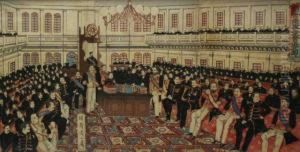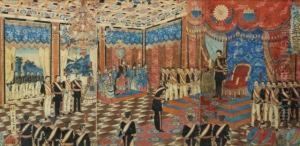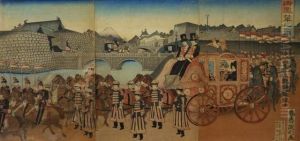Utagawa Nobukazu Paintings
Utagawa Nobukazu was a prolific Japanese woodblock print artist, active during the Meiji period. He was part of the Utagawa school, a famed lineage of artists that significantly influenced ukiyo-e, a genre of Japanese art that flourished between the 17th and 19th centuries. Nobukazu's work spanned the late 19th and early 20th centuries, a period marked by rapid modernization and westernization in Japan. Despite the exact dates of his birth and death being uncertain, his contributions to the world of Japanese art are well-documented through his prints, which continue to be celebrated for their vibrant depiction of Meiji-era life and culture.
Nobukazu specialized in genres that were popular among the ukiyo-e artists of his time, including bijinga (pictures of beautiful women), yakusha-e (actor prints), and senso-e (war prints). His works are characterized by their dynamic compositions, vivid use of color, and the incorporation of Western perspectives and techniques, reflecting the changing tastes and influences of the Meiji period. Nobukazu's ability to blend traditional Japanese elements with Western influences made his prints especially appealing to a society that was navigating the complexities of modernization.
Throughout his career, Nobukazu produced a significant number of triptychs, a format that allowed for expansive and detailed narrative scenes. His war prints, which depicted scenes from the Sino-Japanese War (1894-1895) and the Russo-Japanese War (1904-1905), are particularly notable for their historical value and artistic merit. These works not only serve as a visual record of Japan's military conflicts but also reflect the nationalistic fervor of the time, showcasing Nobukazu's skill in capturing the spirit and emotions of the era.
Despite the widespread recognition of his talent during his lifetime, Utagawa Nobukazu's legacy, like that of many ukiyo-e artists, has been somewhat overshadowed by the most renowned figures of the genre, such as Hokusai and Hiroshige. However, his contributions to the development of late Meiji-era art and his role in the transition of ukiyo-e from traditional to modern styles have gained him a respected place in the annals of Japanese art history. Nobukazu's prints continue to be appreciated by collectors and scholars for their historical significance and artistic beauty, offering a window into the fascinating period of transition in Japan's history.


